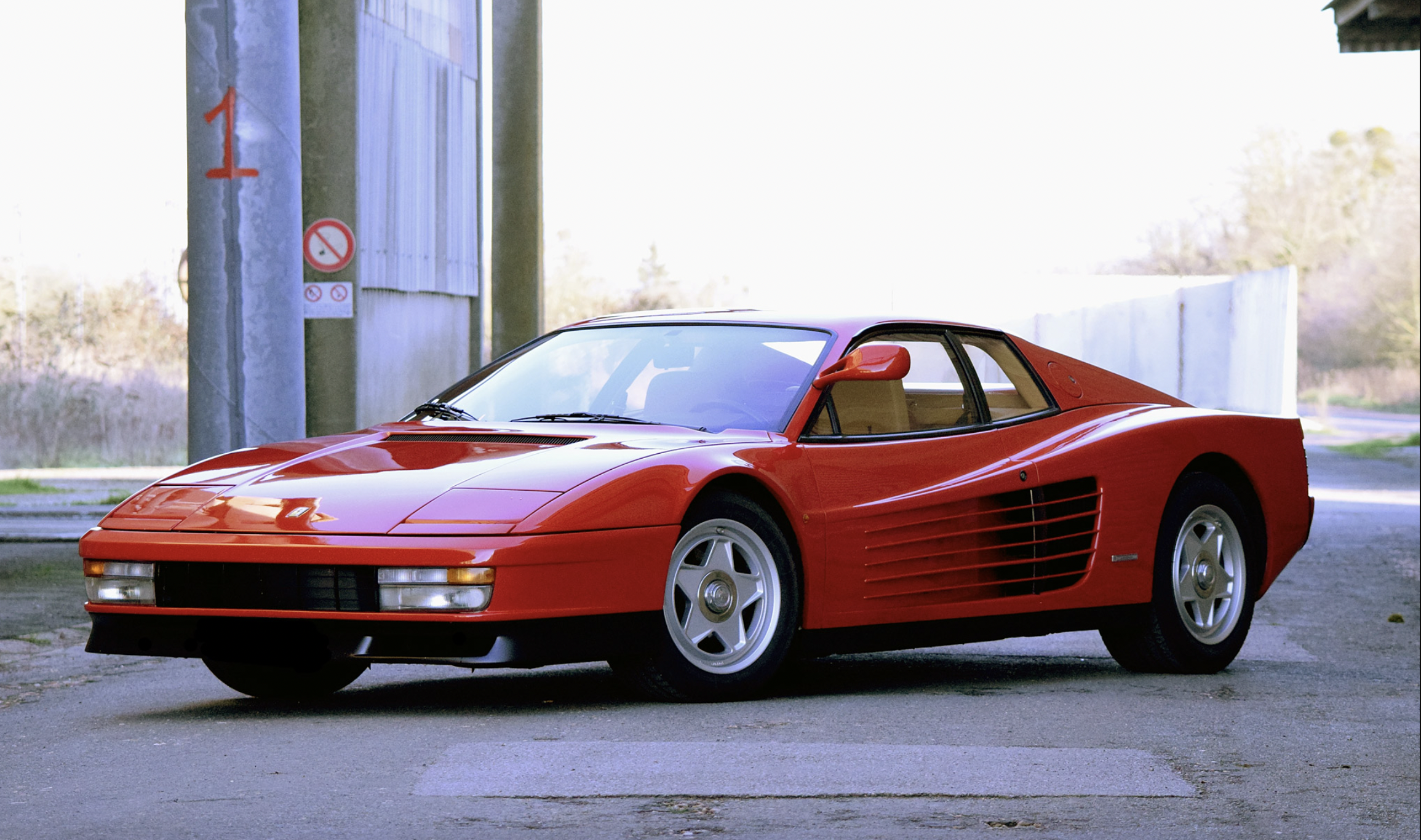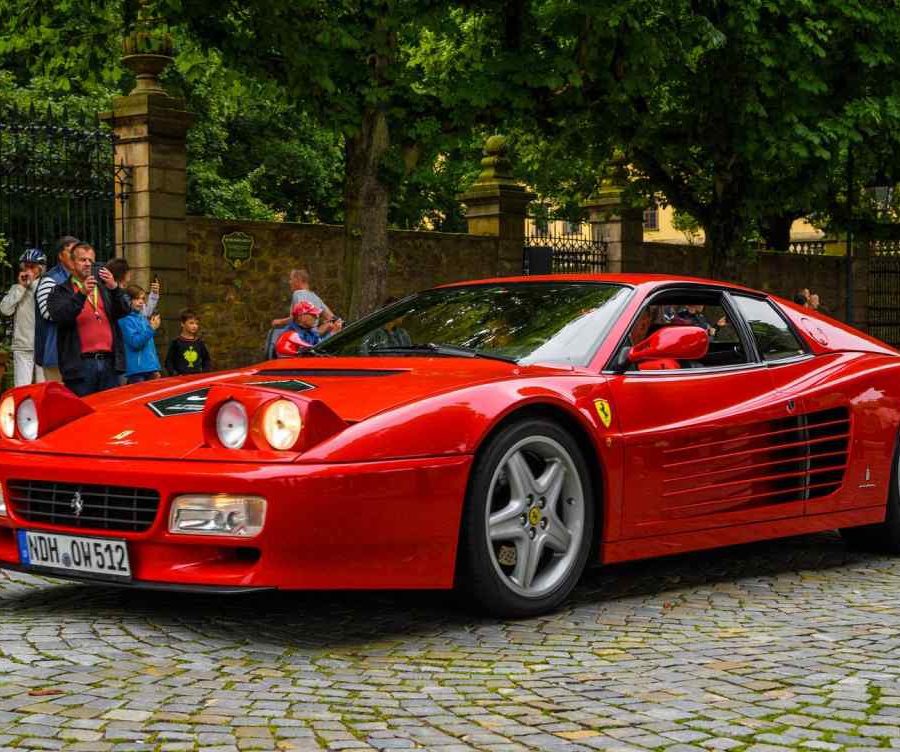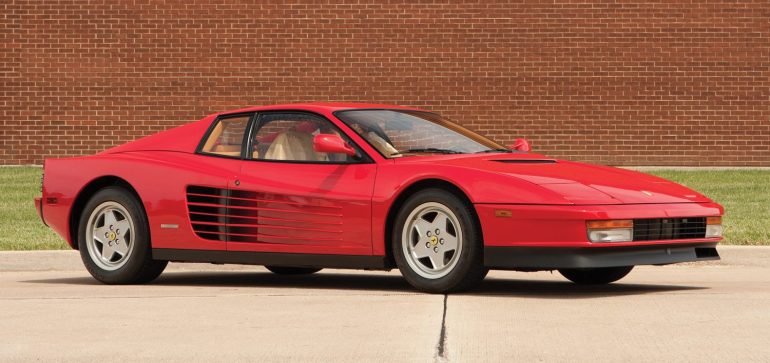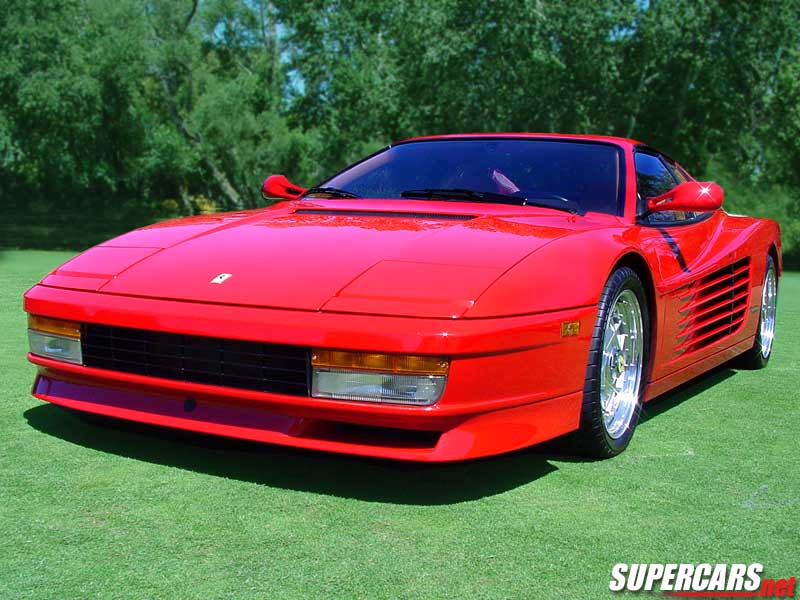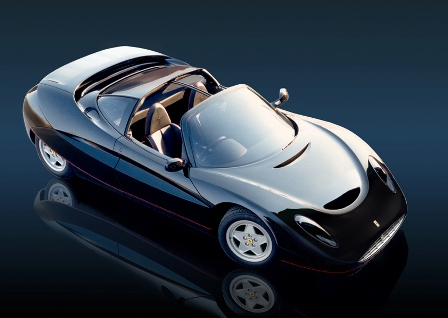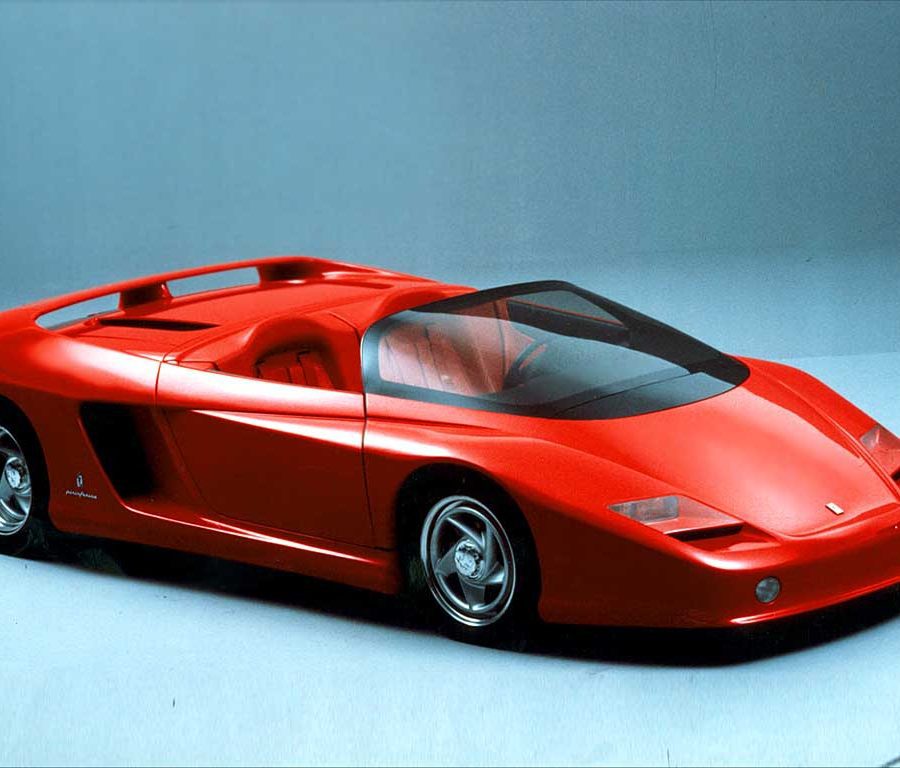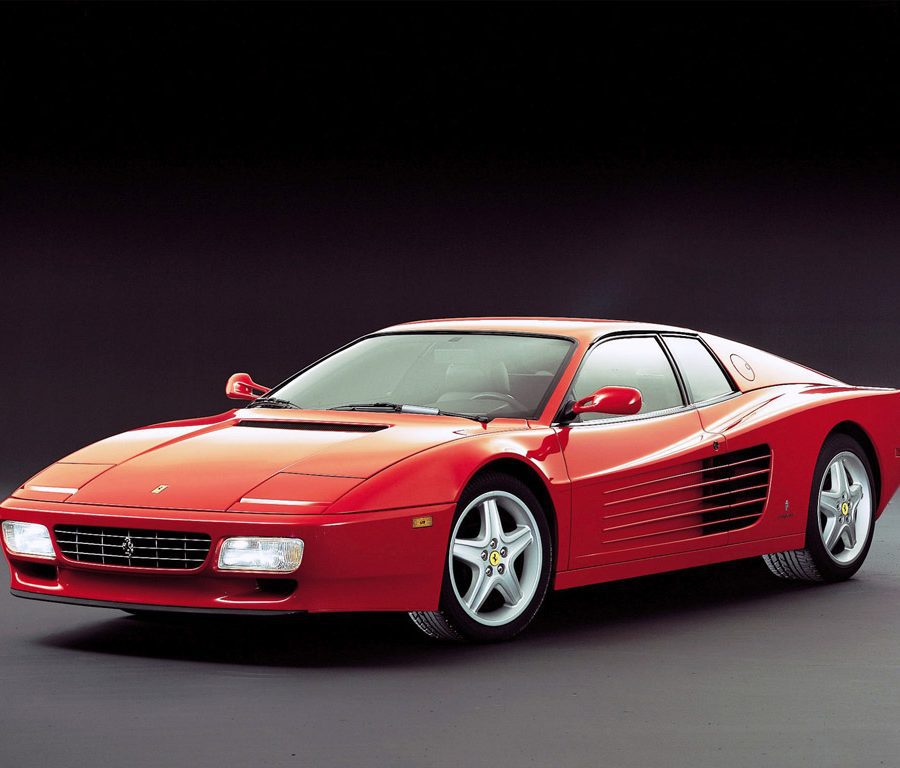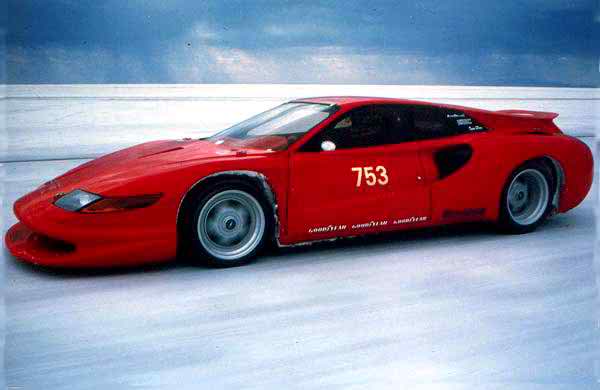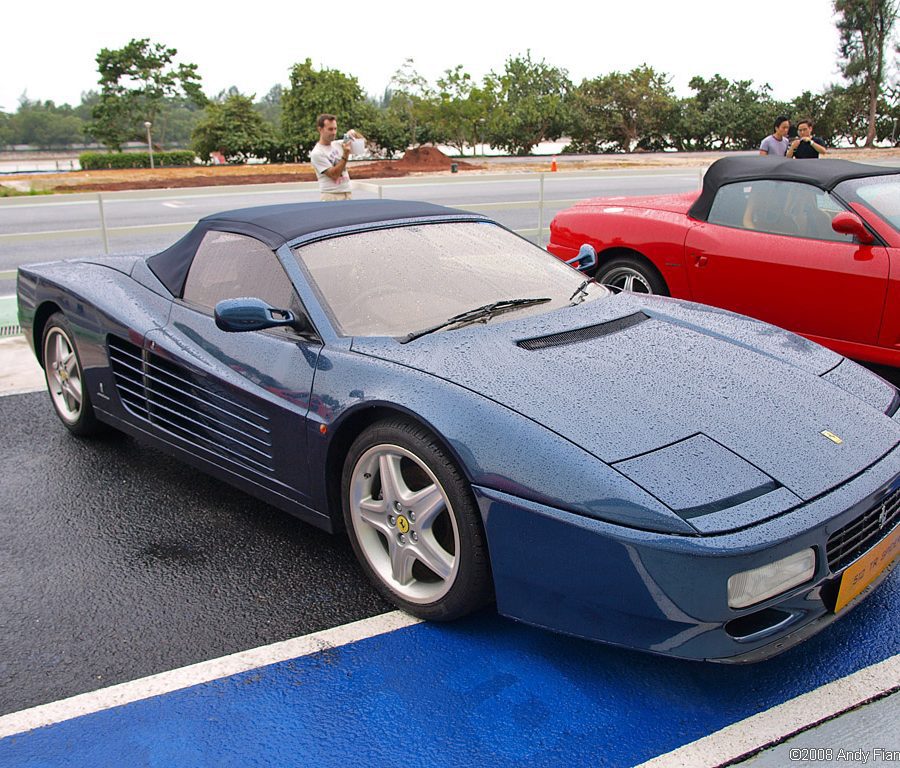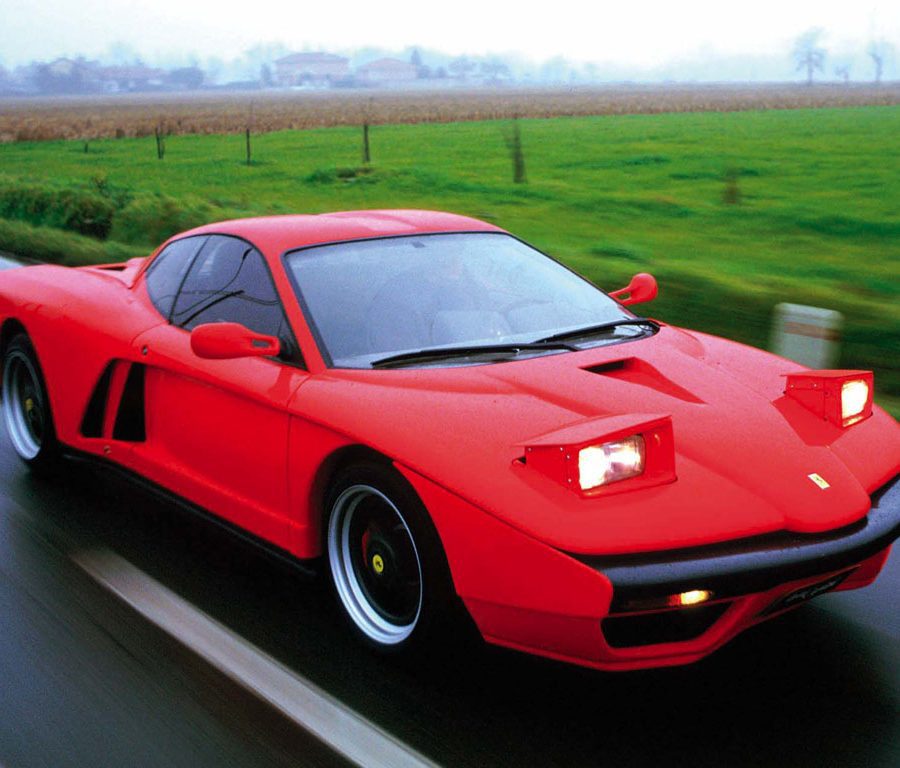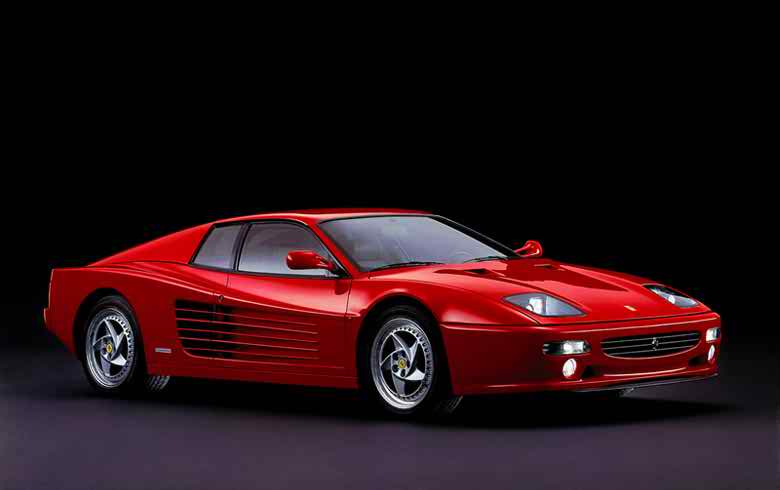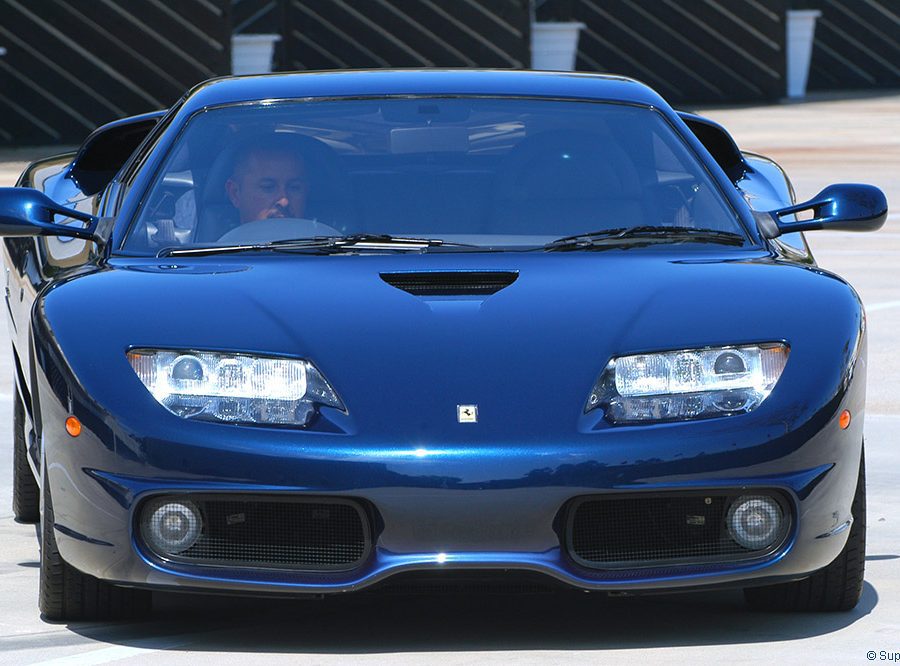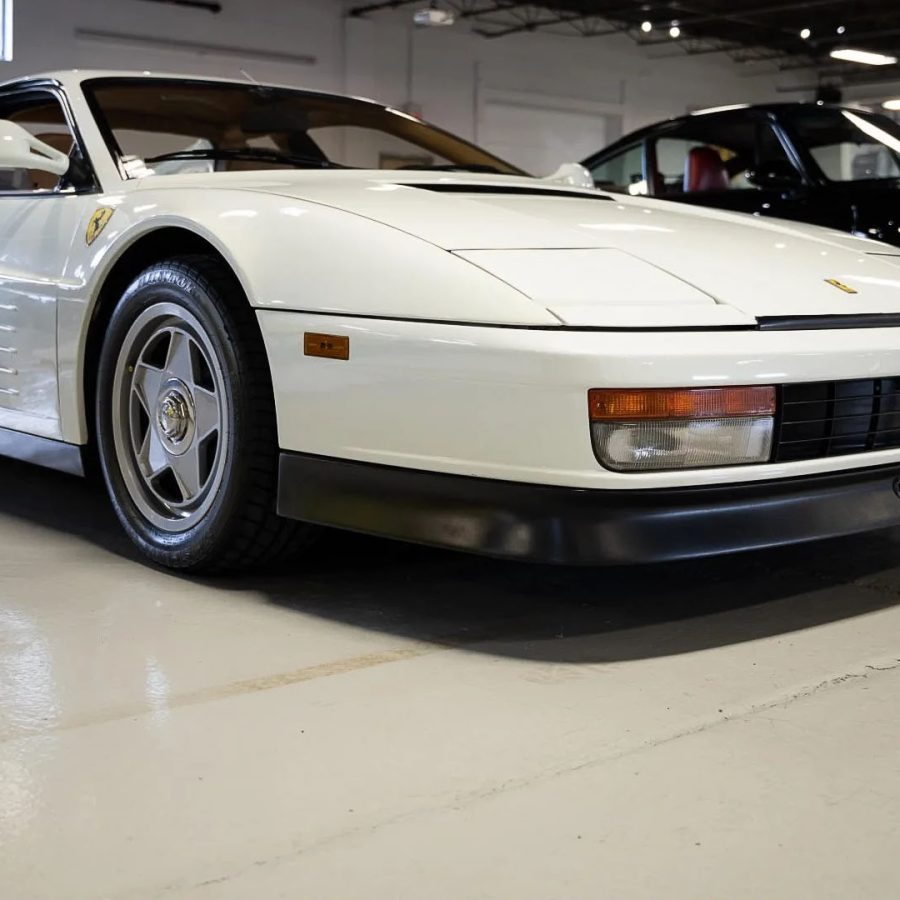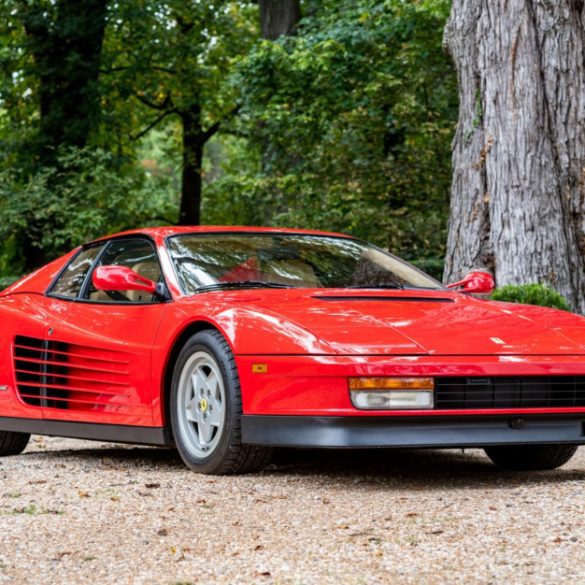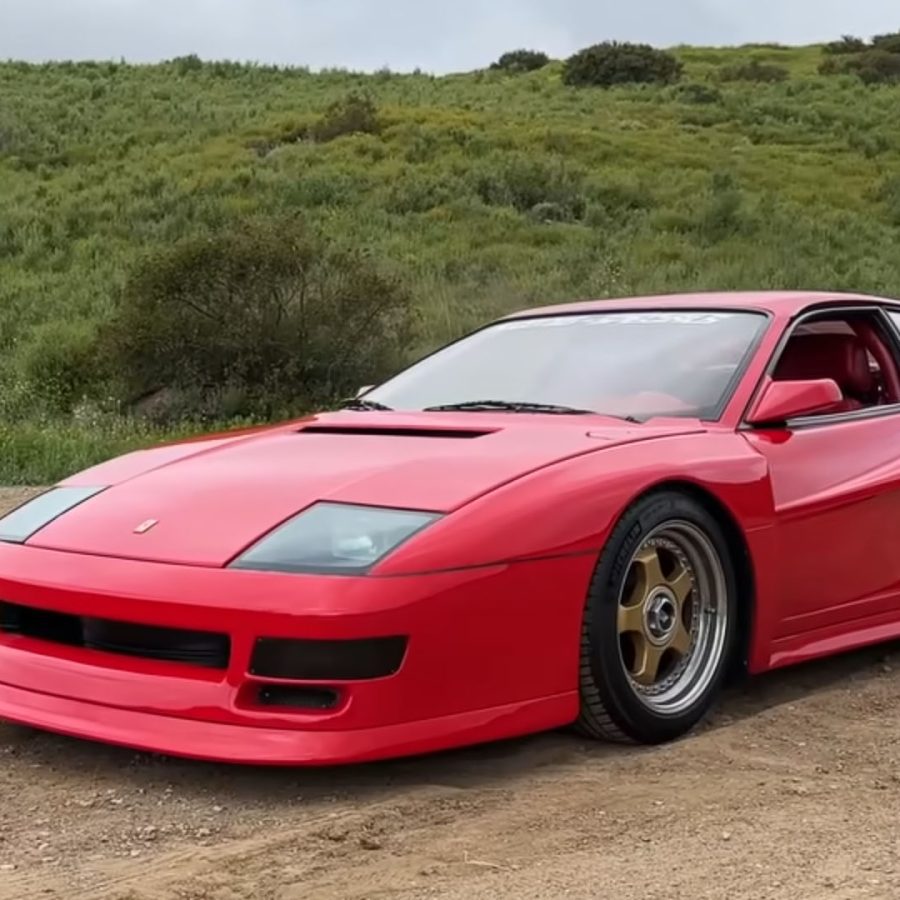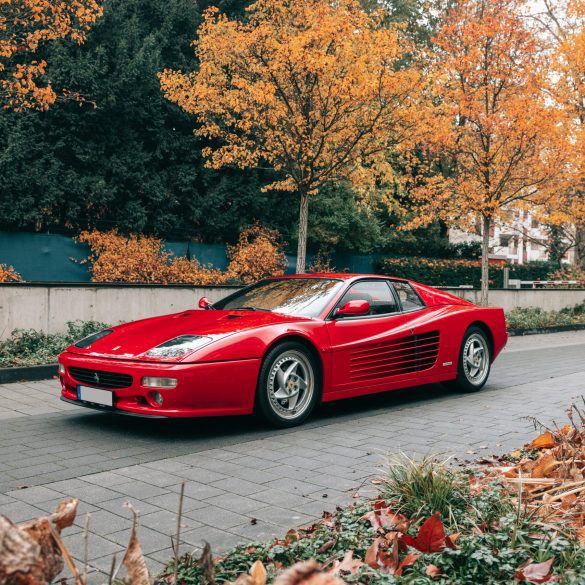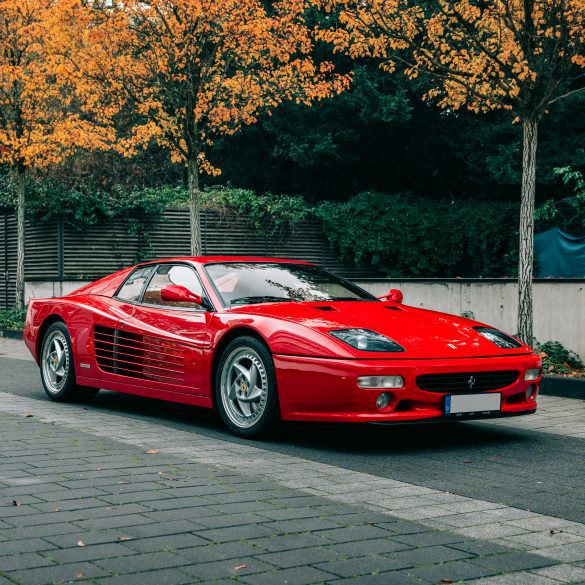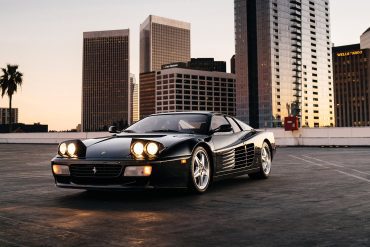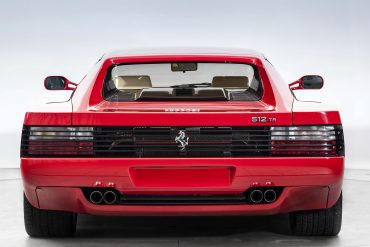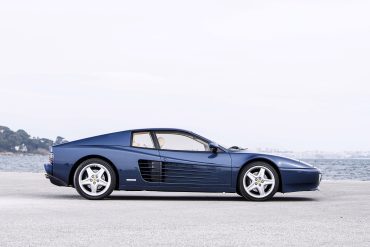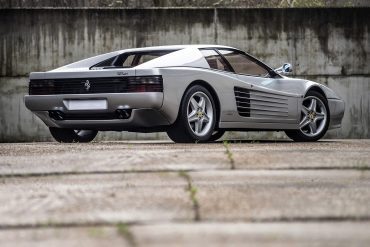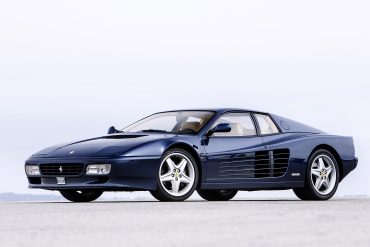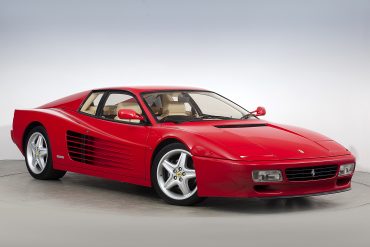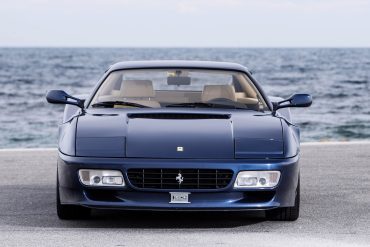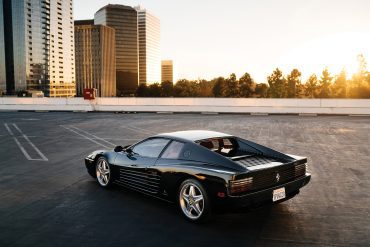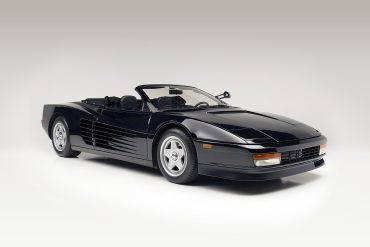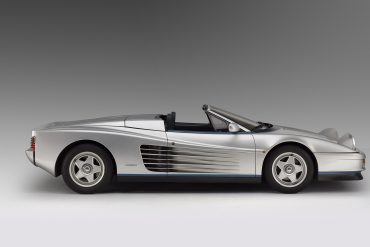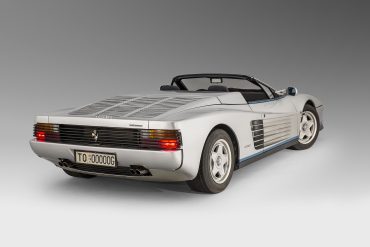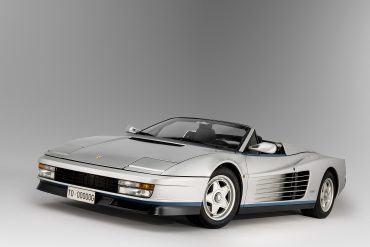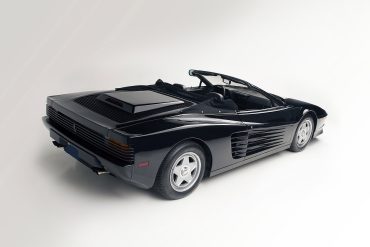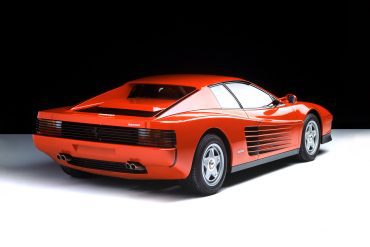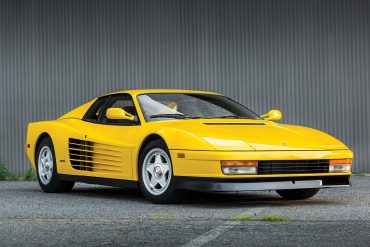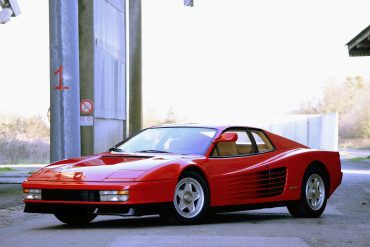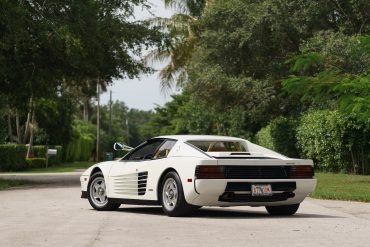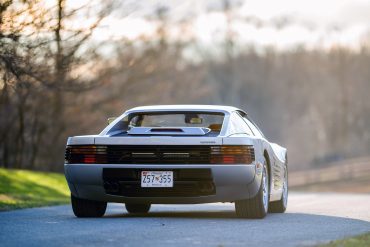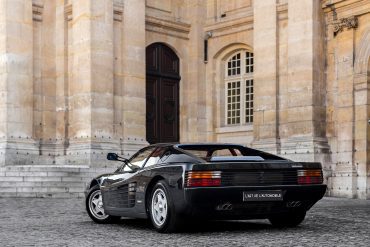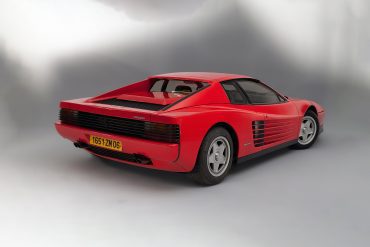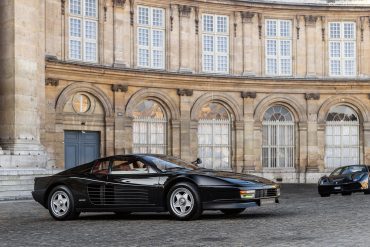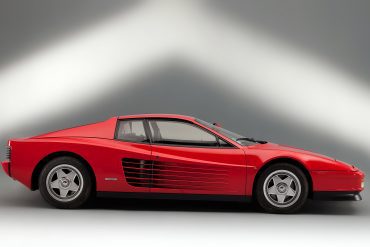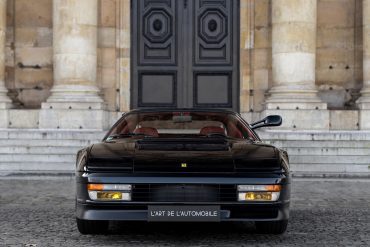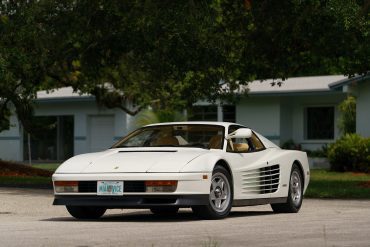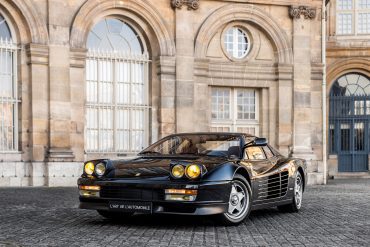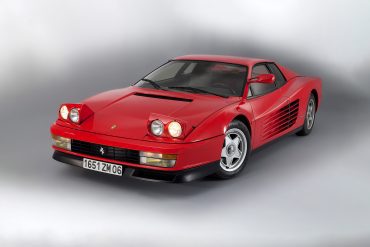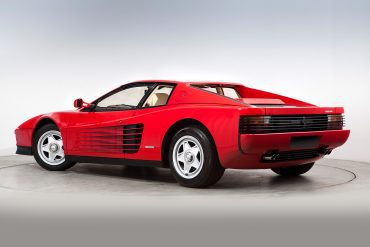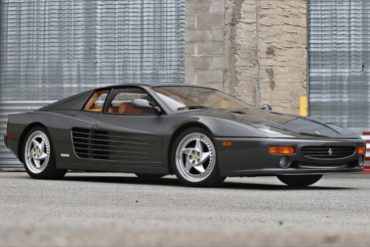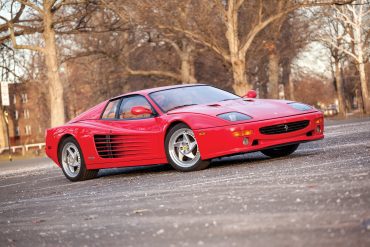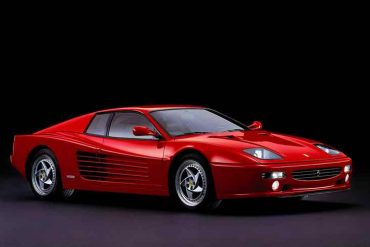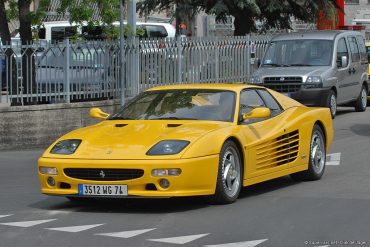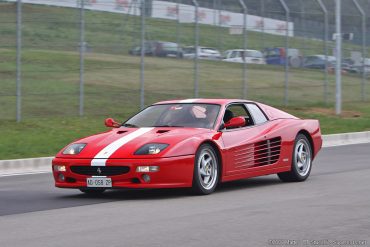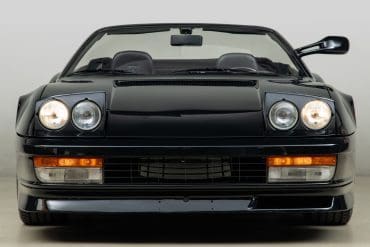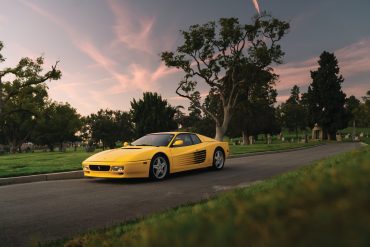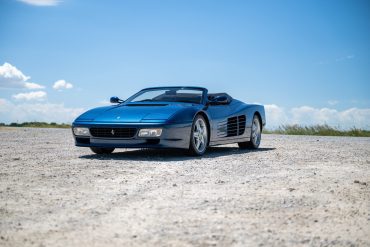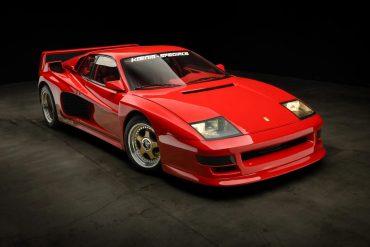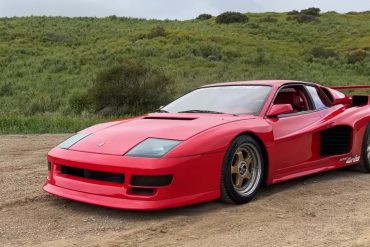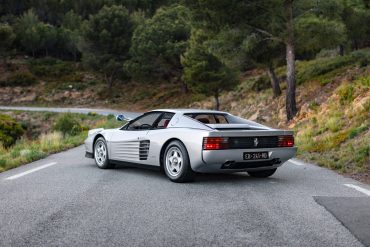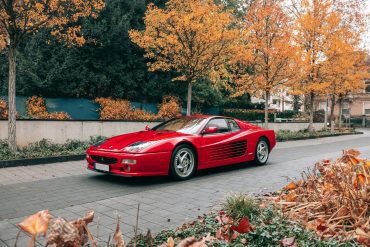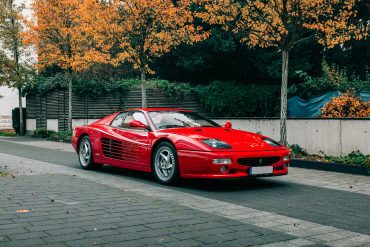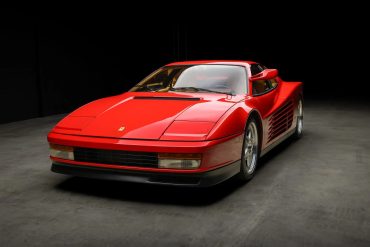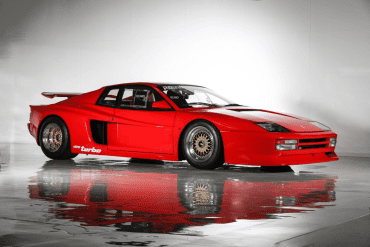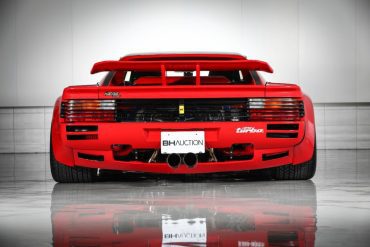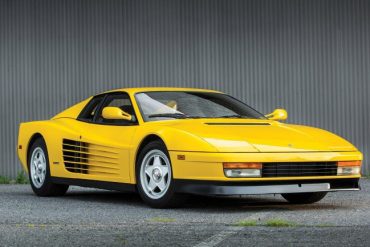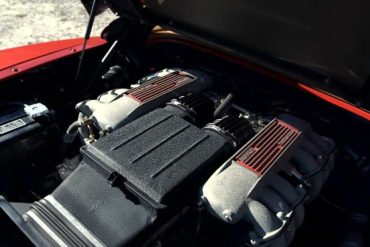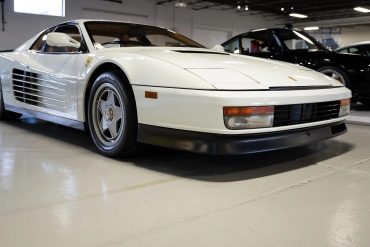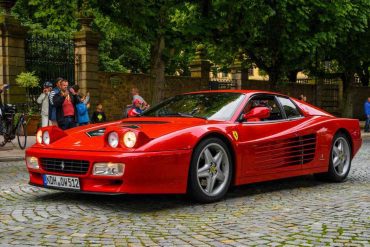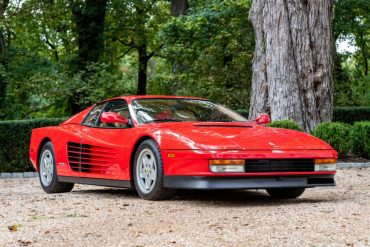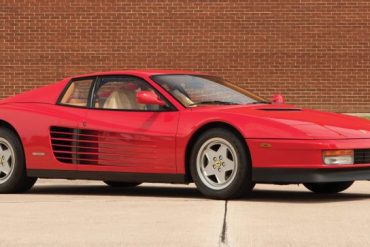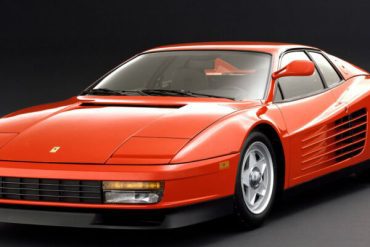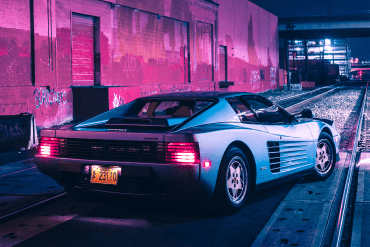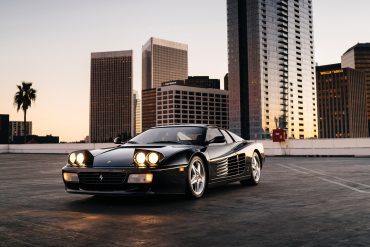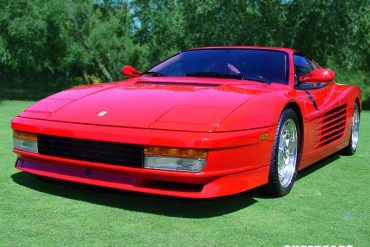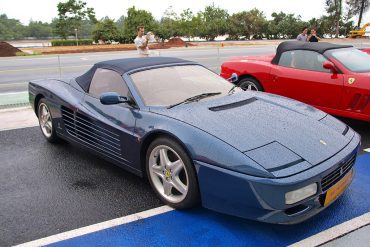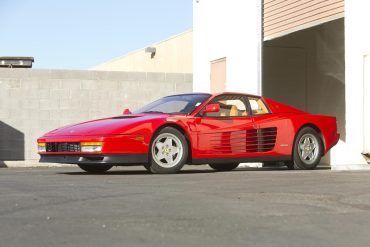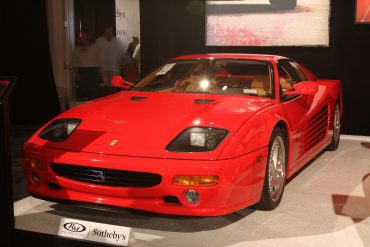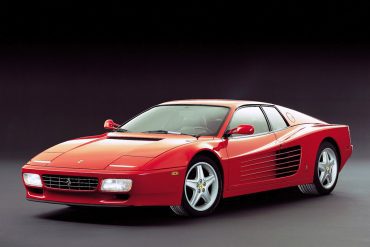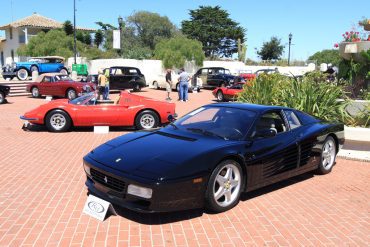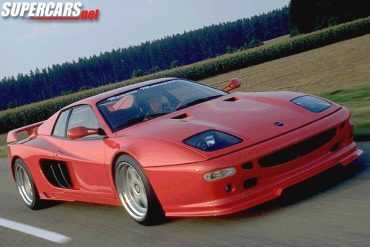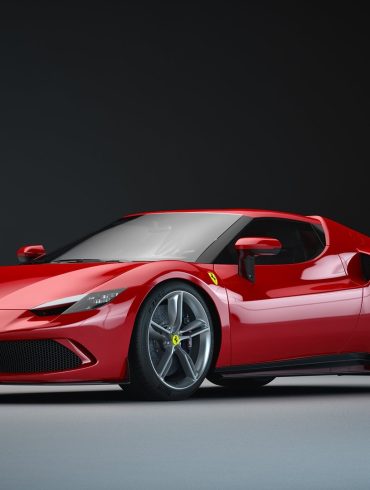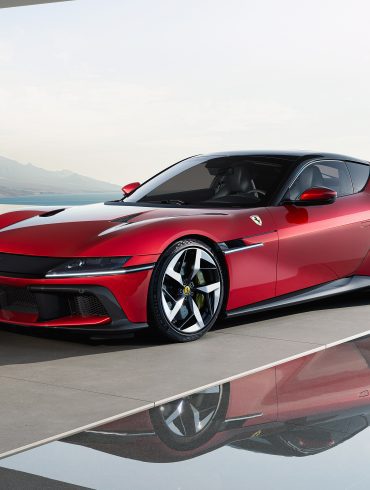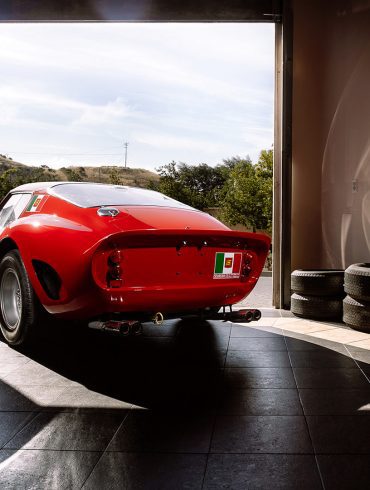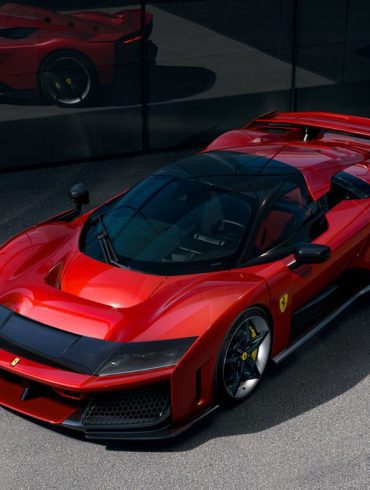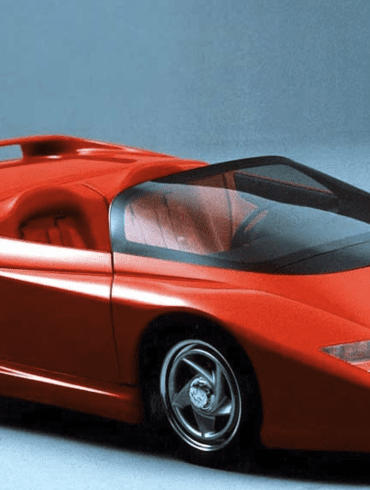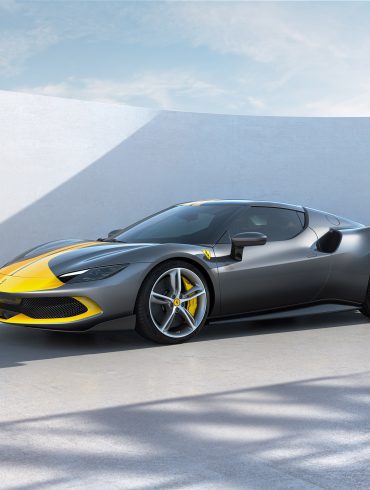Ferrari Testarossa
The Ultimate Guide
Made famous for its role in Miami Vice and Sega’s Out Run, the Testarossa was Ferraris leading supercar in the mid-eighties. Its distinctive side strakes and ultra-wide rear track inspired many other supercar designs and they became a symbol of 1980’s retrograde culture. Dive into the iconic world of the Ferrari Testarossa, the 1980s poster child that redefined supercar style and performance with its flat-12 engine and legendary Pininfarina design! This ultimate guide explores its history, variants, and lasting legacy.
Overview / Variants / Models In-Depth / Buyer's Guide / Videos / Images / More Updates
Ferrari Testarossa - From Poster to Pavement
The Ferrari Testarossa, introduced in 1984, is one of Ferrari’s most iconic models, instantly recognizable for its wide body, side strakes, and flat-12 engine. As a successor to the Ferrari Berlinetta Boxer series, the Testarossa marked a shift in Ferrari’s design and engineering approach, merging dramatic styling with refined performance.
Over the years, the Testarossa evolved into the 512 TR and F512 M, each bringing upgrades that kept the car competitive and aligned with the changing demands of high-performance GT cars. This article explores the history, model variants, performance, critical reception, and lasting legacy of the Ferrari Testarossa and its variants.
Ferrari’s Shift to the Testarossa
The Ferrari Testarossa debuted at the 1984 Paris Auto Show, designed as a replacement for the Ferrari 512 BBi in Ferrari’s flagship lineup. “Testa Rossa” translates to “red head” in Italian, a name Ferrari had used in the late 1950s for its 250 Testa Rossa race cars, in reference to the red-painted valve covers on the engine. The Testarossa name was revived in the 1980s to evoke Ferrari’s racing heritage while introducing a groundbreaking new model.
Ferrari wanted the Testarossa to be a high-performance GT car that could compete with the likes of Lamborghini’s Countach and Porsche’s 911 Turbo. Pininfarina’s design, with its wide body and signature side strakes, became an instant classic, though it was as functional as it was eye-catching. The Testarossa’s wide rear track accommodated a larger rear-mounted radiator setup, improving engine cooling and interior comfort.
Testarossa, 512 TR, and F512 M
The Testarossa saw two significant updates during its production run, evolving first into the 512 TR and later into the F512 M. Each variant introduced performance and design refinements, responding to both market demands and technological advancements.
Ferrari Testarossa (1984-1991)
The original Ferrari Testarossa featured a 4.9-liter flat-12 engine producing 390 horsepower and 361 lb-ft of torque. Paired with a five-speed manual transmission, the Testarossa could accelerate from 0 to 60 mph in 5.2 seconds and reach a top speed of approximately 180 mph. Its mid-engine, rear-wheel-drive layout provided balanced handling, while the flat-12 configuration offered a lower center of gravity.
The car’s unique design was functional as well as aesthetic. The side-mounted radiators, fed by the famous “cheese grater” side strakes, kept the car cool while allowing Ferrari to create a cabin with more space and better airflow. The interior featured luxury touches, with leather upholstery, a high-quality sound system, and ample legroom, catering to drivers who valued comfort as well as performance.
Critics at the time were impressed by the Testarossa’s bold design and smooth power delivery. Car and Driver described it as “an exotic supercar that combines Ferrari’s racing pedigree with grand touring comfort,” highlighting its appeal as both a driver’s car and a status symbol.
Ferrari 512 TR (1991-1994)
In 1991, Ferrari introduced the 512 TR, an updated version of the Testarossa with significant performance enhancements and styling refinements. The 512 TR’s flat-12 engine received upgrades, increasing power to 428 horsepower and 362 lb-ft of torque, allowing it to reach 0-60 mph in just 4.9 seconds and achieve a top speed of 195 mph.
The 512 TR’s improvements extended beyond the engine. Ferrari reworked the intake system, exhaust, and valves, optimizing performance and responsiveness. The car also featured a revised suspension system for better handling and a more stable ride. In terms of design, the 512 TR introduced a restyled front end with integrated fog lights and a revised grille, giving it a sleeker, more modern look. The interior received ergonomic updates, enhancing the comfort and usability of the cabin.
Critics praised the 512 TR’s improvements, with Motor Trend noting that “the 512 TR builds on the Testarossa’s legacy, delivering a sharper, more thrilling driving experience.” The enhancements made the 512 TR a serious contender among supercars of the early 1990s, while still retaining the allure of the original Testarossa.
Ferrari F512 M (1994-1996)
The final evolution of the Testarossa series was the F512 M, introduced in 1994 as Ferrari’s last flat-12 model. The F512 M’s engine output increased to 440 horsepower and 368 lb-ft of torque, achieving 0-60 mph in 4.7 seconds and a top speed of 196 mph. Ferrari made extensive changes to improve weight distribution, handling, and braking performance, making the F512 M the most refined and capable version of the Testarossa.
Aesthetically, the F512 M featured notable design changes, including fixed headlights, a revised front grille, round taillights, and a more aggressive rear diffuser. These updates modernized the car’s look, setting it apart from the earlier Testarossa and 512 TR. Inside, Ferrari added carbon fiber elements and redesigned the seats for a sportier feel.
Automobile Magazine remarked on the F512 M’s evolution, stating that “Ferrari has sharpened the Testarossa concept to create a supercar with impressive capabilities and timeless style.” The F512 M, while divisive among purists due to its departure from the original Testarossa’s design, represented the pinnacle of Ferrari’s flat-12 engineering and remains a sought-after collector’s car.
Radical and Iconic
The Ferrari Testarossa’s design by Pininfarina was as much about function as it was about form. The distinctive side strakes, which became the car’s defining feature, were a solution to cooling challenges posed by the flat-12 engine. By positioning the radiators on the sides and drawing air through the strakes, Ferrari achieved both effective cooling and a spacious cabin, free from the heat issues that plagued previous mid-engined cars.
The wide rear track and low stance gave the Testarossa a striking presence, and the flat-12 engine provided a balanced weight distribution, enhancing handling. This engine design also gave the car a unique exhaust note that became part of its charm.
Ferrari’s approach to luxury in the Testarossa was also notable. The car’s interior was comfortable and well-appointed, with leather seats and advanced (for the time) electronics. This combination of comfort and performance allowed Ferrari to capture a broader audience, making the Testarossa a hit not only among driving enthusiasts but also among those looking for a status symbol.
A 12-Cylinder Powerhouse
The Testarossa series was powered by Ferrari’s flat-12 engine, providing an unforgettable driving experience. Each variant delivered increased performance and responsiveness, reflecting Ferrari’s commitment to refining its flagship model.
Testarossa: The original Testarossa, with 390 horsepower, offered a blend of power and usability. Its mid-range torque and smooth power delivery were particularly appreciated on long drives.
512 TR: The 512 TR introduced more aggressive performance, with sharper throttle response and improved handling dynamics. Its power increase to 428 horsepower gave it a competitive edge among early-1990s supercars.
F512 M: The F512 M represented the peak of the Testarossa’s evolution, with 440 horsepower and fine-tuned handling. The car’s weight distribution and advanced suspension made it the best-handling Testarossa, and its top speed of 196 mph underscored its performance credentials.
Evo Magazine described the F512 M as “the ultimate expression of the Testarossa,” praising its improved handling and acceleration as “transformative.”
A Polarizing Yet Celebrated Icon
At its launch, the Testarossa received acclaim for its design and performance, though some traditional Ferrari fans found it too bold or unconventional. The car quickly became a cultural icon, featured prominently in media such as Miami Vice and synonymous with 1980s luxury and excess. Despite this, the Testarossa’s performance credentials were real, and automotive journalists praised its grand touring capabilities.
Car and Driver noted, “The Testarossa is more than a car; it’s a statement.” While some critics viewed the car as catering too much to image over substance, most recognized it as a capable and engaging GT that could hold its own against the competition.
As Ferrari refined the model, particularly with the 512 TR and F512 M, the Testarossa’s reception grew more favorable. These updates addressed criticisms of the original model’s handling and drivability, cementing its place as a legitimate high-performance car.
A Lasting Influence on Ferrari Design
The Ferrari Testarossa’s impact extends beyond its production years. As Ferrari’s last mid-engine flat-12 model, it represents an era of experimental design and engineering. Its wide-body style, side strakes, and aggressive stance have influenced subsequent Ferrari models and continue to resonate with collectors and enthusiasts.
The Testarossa remains a popular collectible, with values for well-maintained examples continuing to rise. Its unique design and position as a cultural icon make it one of Ferrari’s most recognizable and desirable models.
The Testarossa’s Enduring Appeal
The Ferrari Testarossa, along with the 512 TR and F512 M, embodies Ferrari’s exploration of high-performance GT design in the 1980s and early 1990s. From its groundbreaking design to its powerful flat-12 engine, the Testarossa series remains one of Ferrari’s most memorable and celebrated model lines
Ferrari Testarossa Specs
Manufacturer: Ferrari
Production: 1984–1996
Produced: 9,939 units
Assembly: Maranello, Italy
Designer: Diego Ottina, Leonardo Fioravanti, Ian Cameron, Guido Campoli, Emanuele Nicosia at, Pietro Camardella (512 TR)
Class: Sports car Grand tourer (S)
Body style: 2-door berlinetta
Layout: Rear mid-engine, RWD
Engine: 4.9 L Tipo F113 flat-12
Trans: 5-speed manual
Predecessor: Ferrari 512 BBi
Did You Know?
The Testarossa's most distinctive feature, those side strakes, weren't just for show. They channeled air to the side-mounted radiators, which were necessary because the engine was wider than in previous models.
"Testarossa" translates to "red head" in Italian, referring to the red camshaft covers on its flat-12 engine. This was a nod to Ferrari's Testa Rossa racing cars of the 1950s.
Despite its supercar status, the Testarossa offered decent luggage space under the front hood and behind the seats. It was even possible to fit golf clubs in the car!
The Testarossa is a stunning machine, a visual and technical tour de force that redefines the supercar.
Car and Driver (1985)
Ferrari Testarossa Variants
After a long production run of over 7000 cars, Ferrari updated their Testarossa design into the 512 TR. The 512M was launched in October 1994 at the Paris Salon as the ultimate and final Testarossa. It was also the last of the ageing flat-12 Ferraris which first came on the scene in 1973 with the 365 GT4 BB. The Testarossa also birthed a number of one-off specials which we cover in detail below.
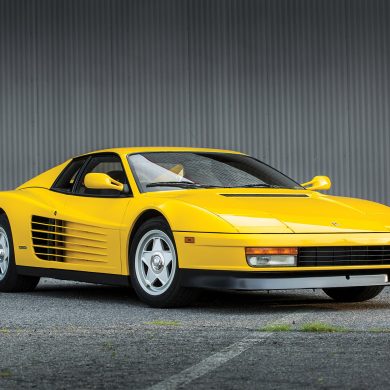
Ferrari Testarossa
Type: Production Car
Years: 1984 - 1991
Production: 7,177 units
Engine: 4.9 L Nat Asp Flat-12
Power: 385 bhp @ 6,300 rpm
Torque: 361 lb/ft @ 4500 rpm
0-60 mph: 5.8 seconds
Top Speed: 180 mph
Compared to the 512i BB it effectively replaced, the Testarossa was a larger car that accommodated mid-mounted radiators. This helped reduce cockpit heat and also had the effect of making the car much wider at the rear. It also provided more space in the front trunk. The Testarossa was powered by a 4.9-liter version of Ferrari’s Boxer-12 which was effectively a 180º V12. Producing 390 bhp, 0–60 miles per hour was typically clocked at 5.2 seconds. Learn more.
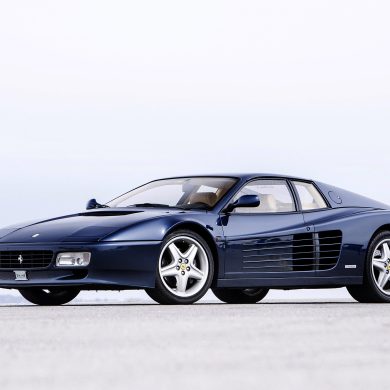
Ferrari 512 TR
Type: Production Car
Years: 1991 - 1994
Production: 2,261 units
Engine: 4.9 L Nat Asp Flat-12
Power: 422 bhp @ 6750 rpm
Torque: 362 lb/ft @ 5500 rpm
0-60 mph: 4.8 seconds
Top Speed: 195 mph
The 512 TR body was slightly updated by Pininfarina, while much work was done by Ferrari under the hood to gain roughly 40 more bhp. The 512 TR's engine was extensively reworked. Nikasil liners were added, along with a new air intake system, Bosch engine management system, larger intake valves, and a revised exhaust system. In addition to the higher peak power, the modifications delivered a more broad power band for better acceleration. Learn more.
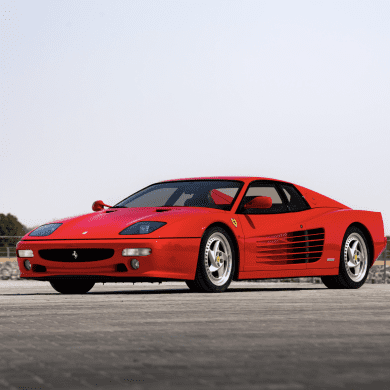
Ferrari F512 M
Type: Production Car
Years: 1994 - 1996
Production: 501 units
Engine: 4.9 L Nat Asp Flat-12
Power: 434 bhp @ 6,750 rpm
Torque: 370 lb/ft @ 5500 rpm
0-60 mph: 4.7 seconds
Top Speed: 196 mph
The result of constant evolution, the 512M shared almost all of its engineering from the 512 TR that came before it. Most of the changes were limited to slight body upgrades that many consider ruin the lines of the original design. At the front a new F355-style front bumper was used with fixed headlights. At the rear, the matt black grille from the TR was reduced and limited to space between the rear lights. Of course the signature side strakes were retained. Learn more.
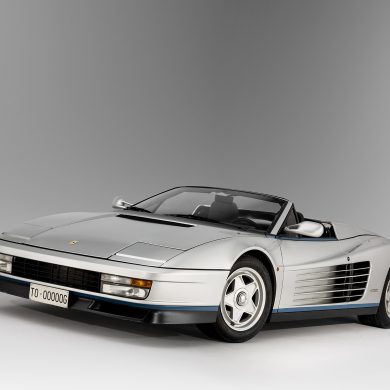
Ferrari Testarossa Spider
Type: One-Off Special
Years: 1986
Production: 1 unit
Engine: 4.9 L Nat Asp Flat-12
Power: 385 bhp @ 6,300 rpm
Torque: 361 lb/ft @ 4500 rpm
0-60 mph: 5.8 seconds
Top Speed: 180 mph
The Testarossa Spider (s/n 62897) is the sole official convertible variant of the Testarossa commissioned in 1986 by the then-Fiat chairman Gianni Agnelli to commemorate his 20 years of chairmanship of the company. Despite many requests from interested customers for a Testarossa Spider, Ferrari refused to produce the car as a regular production variant of the Testarossa, citing spatial and structural challenges that would be difficult to resolve
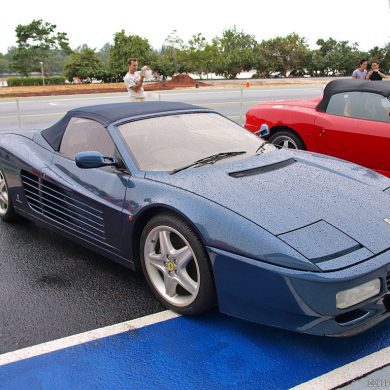
Ferrari F512 TR Spider
Type: Special Edition
Years: 1992
Production: 6 units
Engine: 4.9 L Nat Asp Flat-12
Power: 385 bhp @ 6,300 rpm
Torque: 361 lb/ft @ 4500 rpm
0-60 mph: 5.8 seconds
Top Speed: 180 mph
The factory officially made only one Testarossa Spider and that was for Gianni Agnelli, but five were sold to Brunei. Likewise, no 512 Spiders were made, but six again made it to Brunei. These cars were all part of a secret cottage industry, funded by the Brunei Royal Family to amass the greatest supercar collection possible. Pininfarina sold the cars to Dubai, along with several other unique bodied Bentleys, Rolls-Royces, Mercedes and Jaguars. Learn more.
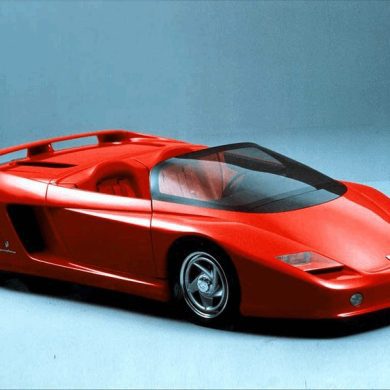
Ferrari Mythos
Type: Concept Car
Years: 1989
Production: 1 unit
Engine: 4.9 L Nat Asp Flat-12
Power: 385 bhp @ 6,300 rpm
Torque: 361 lb/ft @ 4500 rpm
0-60 mph: 5.8 seconds
Top Speed: 180 mph
The Ferrari Mythos was a striking concept car unveiled at the 1989 Tokyo Motor Show. Designed by Pininfarina, it was a radical, futuristic take on the Testarossa platform, featuring a sharply-angled, wedge-shaped body with hidden headlights and a minimalist interior. Despite its dramatic looks and Testarossa-derived 4.9-liter flat-12 engine, the Mythos was never intended for production. Only one fully functional prototype was built (which now resides in a Japanese museum).
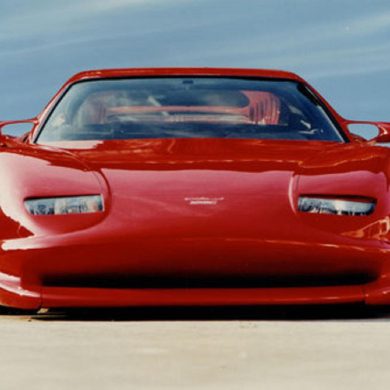
Lotec Colani Testa D'Oro
Type: Tuner Car
Years: 1991
Production: 1 unit
Engine: 4.9 L Twin Turbo Flat-12
Power: 750 bhp @ 6400 rpm
Torque: 664 ft lbs @ 5000 rpm
0-60 mph: N/A
Top Speed: 218.1 mph
Seeking to break a world record for the fastest production car, Swiss-German designer Luigi Colani set out in the late 1980s to modify a Ferrari Testarossa to accomplish the task. The Testa D’Oro was fitted with a Colani-designed body. It features an outrageously long and flat air splitter at the front, jutting out like a giant tongue. The nose of the car itself is pulled into a taut, oval fish-mouthed shape with an air scoop for the braking system. With 700bhp-plus the one-off Testa d’Oro has to be seen to be believed. Learn more.
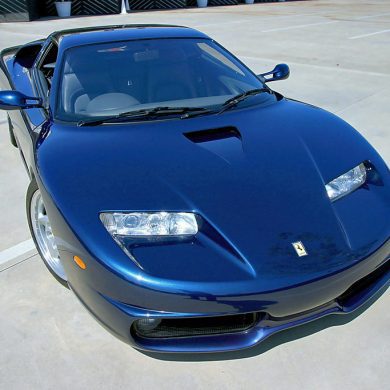
Ferrari FX
Type: One-Off Special
Years: 1995
Production: 1 unit
Engine: 4.9 L Nat Asp Flat-12
Power: 440 bhp @ 6750 rpm
Torque: 369 ft lbs @ 5500 rpm
0-60 mph: N/A
Top Speed: N/A
The Ferrari FX was a truly unique creation, a bespoke supercar commissioned by the Sultan of Brunei in the mid-1990s. Built by Pininfarina with a modified Ferrari 512M chassis, it featured a curvaceous, futuristic design and a groundbreaking 7-speed sequential gearbox developed by Williams F1. Only six examples were ever made, all for the Bruneian royal family, making it one of the rarest and most exclusive Ferraris ever conceived. Learn more.
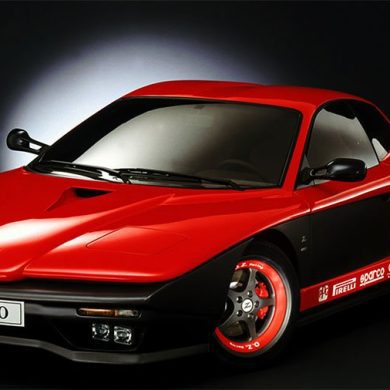
Ferrari FZ93
Type: One-Off Special
Years: 1993
Production: 1 unit
Engine: 4.9 L Nat Asp Flat-12
Power: 428.0 bhp @ 6750 rpm
Torque: 362.1 ft lbs @ 5500 rpm
0-60 mph: N/A
Top Speed: N/A
One of the little known Ferrari prototypes is this one-of supercar built on Testarossa S/N 83935 for the 1993 Geneva Auto Show. Called the Formula Zagato ’93 (FZ93), it followed a small series of curious Zagato 348s and some classic Zagato-Ferraris which were all built in exclusive numbers. FZ93 was penned by Ercole Spada who made a return to Zagato and design this car. It featured stylistic creases, huge air intakes and pleasing curves. Learn more.
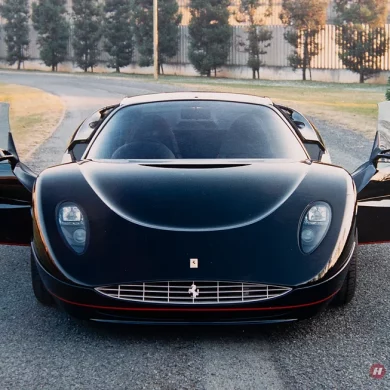
Ferrari F90
Type: One-Off Special
Years: 1988
Production: 6 units
Engine: 4.9 L Nat Asp Flat-12
Power: 385 bhp @ 6,300 rpm
Torque: 361 lb/ft @ 4500 rpm
0-60 mph: 5.8 seconds
Top Speed: 180 mph
After almost 18 years, Ferrari acknowledged that the F90 existed and six were made for the Sultan of Brunei in 1988. A brief passage in the 2005 Ferrari Annual outlined an impressive order of six bespoke supercars which were much more daring than anything Ferrari would have produced themselves. All six F90s used a Ferrari Testarossa chassis which Pininfarina used to sculpt an entirely new body and interior on top of. The engines were stock units but the radiators were moved to the front of the car. Learn more.
Ferrari Testarossa Buyer’s Guide
Everything You Need to Know About Purchasing a Testarossa, 512 TR or F512 M
The Ferrari Testarossa series, with its distinct side strakes and flat-12 engine, is one of Ferrari’s most iconic and widely recognized model lines. Over its production run, the series saw three key versions: the original Testarossa (1984-1991), the updated 512 TR (1991-1994), and the final evolution, the F512 M (1994-1996). Each version brought refinements in performance, styling, and technology. If you’re considering a purchase, here’s what to look for, common issues, and factors affecting desirability and investment potential.
1. Engine and Mechanical Health
All three models in the Testarossa series are powered by Ferrari’s legendary flat-12 engine, which requires careful maintenance to ensure long-term reliability. The flat-12 is a complex and high-performance engine that can incur significant repair costs if issues are neglected.
Timing Belts and Major Services: The timing belt service is one of the most critical aspects of Testarossa ownership. Ferrari recommends changing the timing belts every five years, or sooner if the car has seen spirited driving. This process requires engine-out servicing, which can be costly. Make sure any prospective purchase has recent service records detailing a timing belt replacement, as failure to replace the belts can lead to catastrophic engine damage.
Engine Condition and Compression: Check for consistent maintenance records, including oil changes with high-quality oil. Flat-12 engines are generally robust, but inspecting the compression can give insight into the engine’s health, especially if the car has higher mileage.
Oil and Coolant Leaks: Common issues with the Testarossa’s flat-12 include leaks from the camshaft seals, oil pan, and water pump. Inspect for any signs of oil or coolant leaks under the car, particularly if it has been sitting for an extended period.
Fuel Injection System (512 TR and F512 M): The 512 TR and F512 M use Bosch fuel injection, which is generally reliable but should be inspected for wear. Poor fuel delivery or rough idle could indicate an issue with the fuel injectors or electronic control units (ECUs), which can be costly to replace.
2. Transmission and Clutch Wear
The Testarossa series comes with a five-speed manual transmission, known for its gated shifter and engaging driving experience. However, transmission components and clutches are prone to wear over time, especially if the car has been driven aggressively.
Clutch Life: The clutch can wear prematurely on Testarossas driven in stop-and-go conditions. Inspect for records of recent clutch replacements and test for any signs of slipping, particularly when shifting from a stop. Replacing the clutch is labor-intensive and can be costly.
Smoothness of Gear Shifts: The Testarossa’s transmission should shift smoothly with minimal resistance. Difficulty in shifting, particularly when cold, could indicate worn synchros, a common issue in these models. Pay close attention to second-gear shifts, as this gear is often the first to show signs of synchro wear.
Differential Health: Some Testarossas are known to have issues with the differential, particularly if driven hard. The differential gears can fail over time, leading to serious damage if not addressed. When inspecting, look for any whining sounds or vibrations from the rear axle, and ensure that the differential fluid has been changed regularly.
3. Suspension and Braking System
The Testarossa, 512 TR, and F512 M have a sophisticated suspension system that provides excellent handling but may require attention as the car ages. Each model benefits from progressive improvements, with the F512 M featuring the most advanced suspension setup.
Suspension Bushings and Ball Joints: Worn suspension bushings, control arms, and ball joints are common issues with aging Testarossas. Listen for any clunking noises during a test drive, especially over uneven roads, which may indicate worn suspension components.
Brakes: The Testarossa’s braking system is adequate for the car’s performance but can experience wear. Check the condition of the brake pads, rotors, and calipers, and ensure that the brake fluid has been changed regularly. The 512 TR and F512 M benefit from upgraded braking systems, but all models should have their brake systems carefully inspected.
Shock Absorbers: Worn shock absorbers can affect handling and comfort. Pay attention to any signs of leaking fluid around the shocks and check the car’s service history for recent suspension work.
4. Electrical Systems and Interior Components
The Testarossa series includes advanced electronics for its time, but these can become problematic as the cars age.
Fuse Box and Electrical Wiring: The Testarossa’s electrical system can be prone to issues, particularly with the fuse box and wiring. Inspect the fuse box for signs of overheating or melted connections, as this can indicate an electrical short.
Power Windows and Mirrors: The power windows and mirrors are known for being slow or unresponsive. Check that all electronic components, including the air conditioning, lights, and instrument cluster, work properly. Replacing motors or fixing electrical issues can be labor-intensive.
Interior Condition and Leather Wear: The Testarossa’s interior is a mix of luxury and functionality, with leather seats and trim. Check for any signs of wear, fading, or cracking, particularly on the seats and dashboard. Restoring interior leather can be costly, so look for a car that has been well-maintained in this regard.
5. Desirability and Future Investment Potential
The Ferrari Testarossa series has grown in popularity among collectors, with each variant offering unique attributes and investment potential.
Ferrari Testarossa (1984-1991): The original Testarossa is the most iconic, celebrated for its design and cultural impact, especially as a symbol of 1980s luxury. Early models with low mileage and original specifications are highly sought after, and values have been steadily appreciating. Well-maintained Testarossas are expected to continue appreciating, particularly as demand grows for cars from this era.
Ferrari 512 TR (1991-1994): The 512 TR is considered the best balance of performance, drivability, and classic Testarossa design. With increased horsepower, improved handling, and upgraded styling, the 512 TR appeals to enthusiasts who want a refined driving experience while preserving the spirit of the original. Collectors view the 512 TR as a desirable variant, and its values are on the rise.
Ferrari F512 M (1994-1996): The F512 M, being the last of Ferrari’s flat-12 models, is the rarest and most valuable of the series, with only 501 units produced. Its unique styling updates, including fixed headlights and round taillights, make it distinctive from earlier Testarossas. The F512 M is considered a collectible investment due to its exclusivity and significance as the last model in Ferrari’s flat-12 legacy, and its value is expected to continue appreciating.
6. Summary of Key Inspection Points
When considering a Ferrari Testarossa, 512 TR, or F512 M, prioritize a thorough inspection and focus on the following areas:
Engine: Verify the timing belt service history and inspect for oil or coolant leaks.
Transmission: Test the clutch and gear shifts for smooth operation, particularly second gear.
Suspension and Brakes: Check for worn bushings, ball joints, and brake components.
Electrical Systems: Inspect the fuse box, wiring, and power windows for proper functionality.
Interior Condition: Look for well-maintained leather and a clean interior.
Conclusion
The Ferrari Testarossa series offers a unique combination of design, performance, and cultural significance. As values continue to appreciate, especially for the rarer 512 TR and F512 M models, these cars are becoming increasingly attractive to collectors and enthusiasts. When buying, prioritize examples with well-documented service histories, particularly in relation to timing belt replacements, and look for cars that have been carefully maintained.
Whether you’re drawn to the iconic design of the original Testarossa, the refined performance of the 512 TR, or the exclusive appeal of the F512 M, the Testarossa series represents a collectible investment that embodies Ferrari’s legacy of 1980s and 1990s supercar excellence.
Ferrari Testarossa Images & Wallpapers
A curated collection of our favorite Ferrari Testarossa, 512 TR and F512 M wallpapers and pictures.
The 512 TR is still a head-turner, but it's now a more refined and user-friendly machine.
Autocar (1993)


